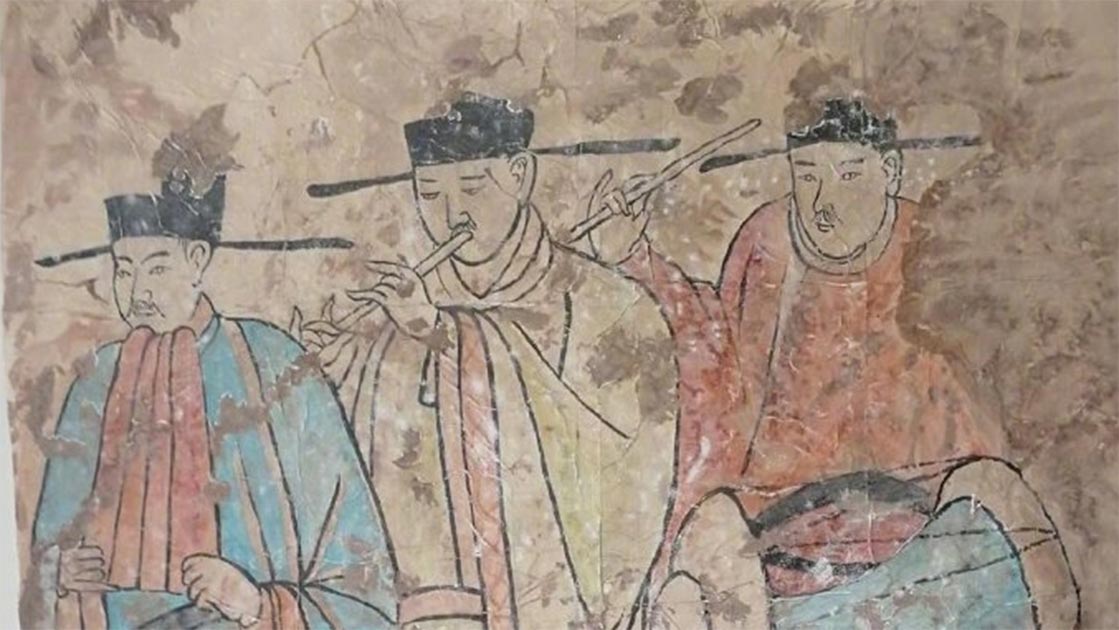Tomb Murals Show Life of the Khitans, A War-Torn Lost Culture
The Inner Mongolia Autonomous Region of northern China includes the rolling green steppes, an arid desert through which the Great Wall of China courses, the Hulunbuir grasslands which are a vast livestock grazing region with hundreds of rivers and lakes, and in the remote west is the Badain Jaran Desert with its immense sand dunes. It was deep within this ancient landscape, near the village of Zizzazz, that during the construction of new roads a group of farmers discovered a 1000-year-old tomb decorated with murals, according to a Xinhua News Agency announcement. The murals were made by the nomadic Khitans.

Scene showing the daily life of the nomadic Khitans. (CFTV)
Who Were the Khitans?
According to staff at the Inner Mongolia Museum of Prehistoric Culture, the tomb was constructed during the middle and late periods of Liao Dynasty (907-1125 AD) by the nomadic Khitan people, who originated in Xianbei in northern China. According to Dr. Xu Elina-Qian from the University of Helsinki in his 2005 paper ‘Historical Development of the Pre-Dynastic Khitan,’ the history of the Khitans dates back to the 4th century, when they dominated much of Mongolia and modern Manchuria in modern-day northeast China.
The Khitans were part of the Kumo Xi tribe until 388 AD when this group was defeated by the newly established Northern Wei, at which time the Khitans consolidated their own tribal identity, leading to the beginning of Khitan written history. They themselves eventually collapsed in the early 12th century.
- The Khitan People: Nomadic Tribe, Chinese Dynasty, Lost to the Mongols
- An Intriguing Empire: The Lasting Impression of the Nomadic Liao Dynasty on Chinese Culture
- How the Jurchen Tribes Conquered China
Kidnapped Sex Slaves of the Khitan “Nobles”
Archaeologists were able to reveal the extent of the ancient murals, which measure about six square meters (64.58 sq. ft.) and “vividly depict people's lifestyles and traditions during the Liao period,” according to the museum where the murals are currently scheduled for repair. Reflecting the lifestyle and traditions of the Khitan Mongols, the frescoes depict common folk playing drums and flutes while others are cooking and cutting hair.

A mural of Khitan daily life – cutting hair. (CFTV)
The Khitans adopted many traditions from the Chinese, and according to Adam T. Kessler’s Empires Beyond the Great Wall: The Heritage of Genghis Khan, one of these was a notion of “ethnic superiority to the other nomadic peoples which they conquered and governed.” Those who fell to the Khitans were regarded as “slaves and other beasts of burden,” and after the Khitans forcibly removed sedentary Chinese farmers from the former Chinese provinces to Inner Mongolia, records state “they were treated only marginally better” than slaves.
Towards the end of their dynastic reign, the Liao dynasty quelled Khitan uprisings with “extreme brutality,” but the Khitans also displayed acts of horrendous cruelty. For example, after conquering the Jurchen nomadic people in the 10th century, records describe the kidnapping of Jurchen women for the purpose “of forced prostitution, catering to Khitan nobility.”
The Culture-Shattering Turbulence of War
Enraged, with the help of the Song military, the Jurchens eventually toppled the Liao dynasty in the early twelfth century, and by 1115 AD they had established the Chin dynasty (1115-1234 AD) which controlled a large area of Khitan territory. After almost a decade of the worst warfare imaginable, the Liao dynasty collapsed in 1125 AD and the Khitan people were absorbed into the Jurchen population.
Fleeing from the Mongol invasions, in 1216 AD the Khitans defeated Goryeo armies and reached the gates of their capital city, but Goryeo General Kim Chwi-ryeo pushed them back north to Pyongan, where the remaining Khitans were finally slaughtered by allied Mongol-Goryeo forces in 1219 AD. According to Michal Biran’s 2017 book, The Mongols and Nomadic Identity: The Case of the Kitans in China, during the early 13th century the Mongol invasions and conquests had a large impact on shifting ethnic identities in the Eurasian Steppe and fleeing Khitans were scattered across Eurasia. They were eventually assimilated into the Mongol Empire.
- The Forgotten History of Beijing’s First Forbidden City
- The Eagle Huntress: Ancient Traditions, and Evidence for Women as Eagle Hunters – Part I
- 1,000-year-old Chinese tomb contains spectacular murals, touching poems, and ceiling of star constellations

Another of the Khitan murals found in the tomb. (CFTV)
The Importance of the Khitan Tomb Murals
And it is for these reasons the discovery is so important, not only because the 1,000-year-old Khitan tomb murals depict day to day life at the height of their reign during the middle-period of the Liao dynasty, when peace was maintained across their territories, but because this unique stone burial chamber serves as a monument to that entire war-torn lost culture.

Pao-shan Tomb Wall-Painting of Liao Dynasty: Noble Consort Yang is teaching a parrot to chant sutras. (Public Domain)
Top Image: Farmers in Inner Mongolia discovered this ancient fresco depicting Khitans playing music. Source: Xinhua
By Ashley Cowie



















